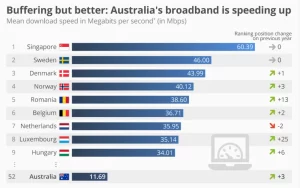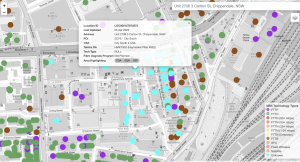
“It’s frustrating because we’re the ones suffering from slow speeds, and there’s nothing we can do.”
According to the Speedtest Global Index (2025), , Australia currently ranks 52nd globally for fixed broadband speeds, with an average download speed of just 11.69 Mbps.
This places it significantly behind many developed and even developing nations. For comparison, countries like Singapore, United States, and South Korea all report average speeds exceeding 250 Mbps, while Thailand and Peru record speeds of over 200 Mbps.
Despite these disparities, Australians continue to pay comparatively high prices around A$70 per month for connections that lag behind international standards. This combination of high cost and low performance has become a key point of concern in national debates about digital equity and infrastructure reform.

Global Broadband Speeds
Why FTTP Matters
To understand why Australia continues to lag in connectivity despite significant investment, it is essential to examine the differences between the broadband technologies currently in use.
Fibre to the Premises (FTTP) delivers fibre-optic cables directly to the user’s home, providing the fastest and most reliable internet connection available. In contrast, Fibre to the Node (FTTN) only brings fibre to a nearby street cabinet, with the remaining distance covered by outdated copper telephone lines often resulting in reduced speeds and reliability.
Other technologies, such as Fixed Wireless and Satellite, are typically used in rural or remote areas where fibre has not been deployed. While they offer basic access, these connections are significantly more vulnerable to latency, dropouts, and speed fluctuations caused by weather conditions, terrain, or network congestion.
“I Use My Phone to Hand in Assignments”
For JianCong Chen, a 23-year-old university student living in the student-heavy suburb of Chippendale, Sydney, the internet is both essential and unreliable.
“I’ve had Zoom classes where the lecturer’s screen froze every few minutes,” he said. “Eventually, I gave up and just used mobile data to attend classes and submit assignments.”
Chen’s area has very limited access to Fibre to the Premises (FTTP). His situation is far from uncommon. According to the Australian Communications and Media Authority (ACMA), nearly 900,000 Australians still rely on Fibre to the Node (FTTN), fixed wireless, or satellite services echnologies more prevalent in low-income and remote communities.
“Sometimes I go to campus just to get a stable connection,” Chen said with a laugh and a pause. “But when it starts affecting your grades, it’s not funny anymore.”
 Internet coverage
Internet coverage
The System That Traps Renters and Low-Income Users
In 2025, the federal government announced that 95% of FTTN premises would become eligible for fibre upgrades. But there’s a catch: the upgrade only happens when residents voluntarily sign up for high-speed internet plans. For homeowners, that may be a budgeting choice. For renters, it’s often out of their hands.
“I’m renting, so I can’t request infrastructure changes,” said Chen. “Even if I wanted an upgrade, it’s not up to me.”
According to the Australian Bureau of Statistics, more than 30% of Australians live in rental housing. That means millions including students, young professionals, and low-income families are effectively blocked from accessing faster and more stable broadband services. Worse still, awareness about the fibre upgrade process is low.
“I didn’t even know it was an option until I saw a post on Reddit,” Chen said. “The government hasn’t exactly advertised it.”
A Decade of Policy Confusion
The core technology behind Wi-Fi was developed in Australia in 1992 by the Commonwealth Scientific and Industrial Research Organisation (CSIRO). Yet over the past decade, broadband policy decisions have widened not closed the digital divide.
The National Broadband Network (NBN), first proposed in 2009, was envisioned as a nationwide FTTP network delivering fast, future-proof internet to 93% of households. But after a change in government in 2013, the project was restructured into a Multi-Technology Mix (MTM), relying more heavily on FTTN as a “cheaper and faster” solution.
A 2015 parliamentary report found that the shift to MTM added roughly A$15 billion in additional costs while resulting in “slower and less reliable” services than originally planned.
In 2021, NBN Co began offering FTTP upgrades in FTTN areas but only for customers who subscribed to plans of at least 100 Mbps. This trigger-based model continues to exclude those unable to afford premium-tier services.
“We already pay international tuition and Sydney rent,” Chen added. “There’s simply no room in my budget for a high-end internet plan.”
More Than an Inconvenience
Australia’s broadband challenges go far beyond inconvenience they reflect a structural failure to ensure fair access to digital infrastructure. Many Australians still rely on copper-based Fibre to the Node (FTTN) networks, with average broadband speeds consistently falling below the global median. In practice, internet access in Australia remains deeply tied to socioeconomic status. Renters, low-income households, and residents in remote areas face not only slower speeds but also limited choice and bargaining power.
As illustrated by JianCong Chen’s personal experience, the current system effectively penalises individuals based on their income, housing situation, and geographic location. Fibre to the Premises (FTTP) connections are far from universal, and the government’s upgrade model requiring customers to opt into high-cost plans excludes renters and low-income families from accessing future-ready infrastructure. The burden of upgrading falls on individuals, many of whom lack the authority or financial means to act.
What Can Be Done?
Advocacy groups are calling for major changes to the NBN upgrade model. Their key recommendations include:
- Making FTTP upgrades automatic rather than application-based
- Providing subsidies for renters and low-income households
- Reclassifying broadband as a public utility under universal access standards


Be the first to comment